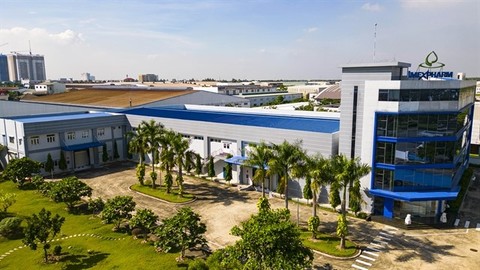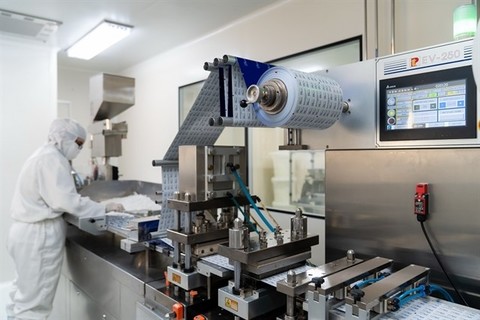
The IMP4 high-tech Imexpharm antibiotic factory in Bình Dương Province. — Photo imexpharm.com
The pharmaceutical industry's growth momentum was fading in the first quarter of the year, as companies grappled with fluctuating and rising prices of raw materials and intensifying competition in the market.
The industry is an essential sector that is typically less impacted by economic slowdowns. However, weak demand has posed challenges for this fast-growing industry in Việt Nam.
After record profits and strong growth in 2023, the industry's momentum faced limitations in 2024 due to rising raw material costs and increased market competition.
SSI Securities Corporation forecasts pharmaceutical profit growth of 8.4 per cent in 2024, lower than the 15.5 per cent projected for the market's benchmark VN-Index. It estimates an 8 per cent increase in revenue and a 6 per cent net profit growth for companies in the industry.
The lower projected net profit growth is due to the rising costs of Active Pharmaceutical Ingredients (API), as well as the healthcare market having lower gross profit margins compared to retail.
While 2023 was a good year for the industry, SSI believes it will hardly achieve the same momentum this year.
In fact, the industry's business results have largely remained flat or seen only slight improvements compared to 2023.
Rising revenues, falling profits
In the first three months, top pharmaceutical firms like DHG Pharmaceutical (DHG) and Imexpharm Corporation (IMP) experienced a paradoxical situation as their revenue increased while profit dipped.
Despite a slight rise of 2.4 per cent in net revenue, DHG reported a 38.4 per cent year-on-year decline in profit after tax to VNĐ222.2 billion (US$8.7 million).
This was largely attributed to a more than 21 per cent spike in the cost of goods sold, which sharply erased gross profit margins.
Similarly, Imexpharm saw its net revenue grow nearly 2.5 per cent over last year to VNĐ491.1 billion, but its profit after tax dropped 20.5 per cent to over VNĐ61.9 billion.
While many companies in the same industry have reported increasing revenues but declining profits, there are still some businesses that have seen both their revenues and profits decrease.
Imexpharm's leadership cited three main reasons for the mixed results, including higher input material prices, intense market competition and the IMP4 factory coming online in the third quarter of 2023, which led to rising depreciation and operating costs.
Meanwhile, during the same period, Bidiphar saw a slight gain in net revenue to VNĐ383.8 billion, but the cost of goods sold climbed at a faster pace than revenue, causing gross profits to drop more than VNĐ2 billion to VNĐ188.5 billion.
After deducting expenses, the company reported a profit after tax of VNĐ67.1 billion, which showed no change from the same period last year. Nevertheless, it has already earned 25 per cent of its full-year profit target of VNĐ320 billion in just the first three months.

A worker inside a lab at DHG Pharmaceutical. — Photo dhgpharma.com.vn
Poor results
On the other hand, some even witnessed declines in both revenues and profits.
For instance, Vinapharm recorded consolidated net revenues of VNĐ1.19 trillion, down 3 per cent on-year, and profit after tax of VNĐ94.4 billion, down 15 per cent. The falls were due to poor business results at its parent company, some subsidiaries and associated companies in the first quarter.
Traphaco also saw a 11.6 per cent drop in net revenue, to nearly VNĐ547.5 billion. Although the company reduced costs and its financial income increased, the large decline in revenue led to a loss of 32 per cent in profit after tax to VNĐ54 billion.
Traphaco has enjoyed three consecutive years of strong profit growth, including a record year in 2022 and its second highest profits in 2023.
First quarter profits at the pharmaceutical firm are also higher than in the same period in 2021, when the Traphaco's strong profit streak began. However, the significant decline in profits is likely to indicate that the company has passed its peak profitability.
According to SSI, policies are expected to continue supporting domestic pharmaceutical manufacturing companies in 2024. A key policy expected to be passed this year is an amendment of the Pharmaceutical Law, which aims to help reduce challenges and provide more incentives for domestic enterprises to pursue higher standards.
The securities firm said that these policies will help local manufacturers improve their market share compared to imported healthcare products. However, the impact of these policies will be more evident in the following years, starting in 2025.
Mirae Asset Vietnam Securities Company also believes that legal and regulatory reforms will help drive growth in Việt Nam's pharmaceutical sector.
The financial services firm forecasts that the value of the country's pharmaceutical market will reach $7.89 billion in 2024, a 9.1 per cent increase year-on-year. — VNS